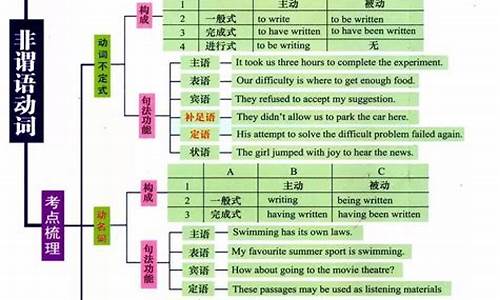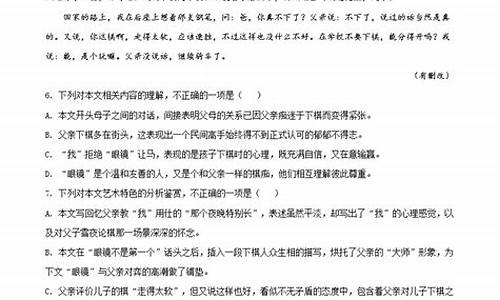您现在的位置是: 首页 > 教育分析 教育分析
高考英语知识点归纳总结,高考英语知识点归纳总结人教版
tamoadmin 2024-05-20 人已围观
简介高考的单词量是3000个,繁多且难以记忆。把重点的单词 总结 归纳起来,是不是容易多了?下面由我给你带来关于高考英语重点单词用法总结,希望对你有帮助! 高考英语重点单词用法总结1 1.able 用法:be able to do Note: 反义词 unable表示不能,而disabled表示残疾的。 be able to do可以表示经过艰难困苦才能做到的事。 2.abroad

高考的单词量是3000个,繁多且难以记忆。把重点的单词 总结 归纳起来,是不是容易多了?下面由我给你带来关于高考英语重点单词用法总结,希望对你有帮助!
高考英语重点单词用法总结1
1.able 用法:be able to do
Note: 反义词 unable表示不能,而disabled表示残疾的。
be able to do可以表示经过艰难困苦才能做到的事。
2.abroad 用法:表示到(在)国外,是一个副词,前面不加介词。
Note: 可以说from abroad, 表示从国外回来。
3.admit 用法:表示承认的时候后面要加上动名词形式。
Note: 表示允许进入的时候与介词to搭配。
4.advise 用法:advise sb. to do; advise doing
Note: 后面的宾语从句要用虚拟语气。即:advise that sb. (should) do的形式。
5.afford 用法:通常与动词不定式搭配使用。
Note: 前面需要有be able to或can等词。
6.after 用法:表示在时间、空间之后;be after表示追寻。
Note: 用在将来时的时候后面接一时间点,而in接一个时间段,如:after 3 o?clock; in 3 days.
7.agree 用法:与介词on, to, with及动词不定式搭配。
Note: agree on表示达成一致;agree to表示批准;agree with表示同意某人说的话。
8.alive 用法:表语性形容词,在句中只能作表语,不能作定语。
Note: 可以作状语使用,表示活活地,如:bury sb. alive.
9.allow 用法:allow doing; allow sb. to do
Note: 可以表示允许进入,如:Please allow me in.
10.among 用法:用在三者或三者以上的群体中。
Note: 还可以表示其中之一,如:He is among the best.
11.and 用法:用于连接两个词、 短语 、 句子 或其他相同结构。
Note: 与祈使句搭配时往往可以表示条件。如:Work hard, and you?ll succeed sooner or later.
12.another 用法:表示又一个,泛指,相当于one more的含义。
Note: 不能直接加复数名词,需要与一个数词搭配,如:another 2 weeks.
13.answer 用法:及物动词,但在作名词时要与介词to搭配。
Note: 可以表示接电话、应门等。如:answer the phone/door.
14.anxious 用法:be anxious for/about/to do
Note: be anxious about表示担心;be anxious for表示盼望得到。
15.appear 用法:不及物动词,没有宾语,没有被动语态。
Note: 还可以作为系动词,与seem同义,表示看起来。
16.arrive 用法:arrive at表示到一个小地方;arrive in表示到一个大地方。
Note: 引申含义表示得出,如:arrive at a decision/conclusion.
17.ask 用法:ask to do; ask sb. to do; ask for
Note: 后面的宾语从句要用虚拟语气。即:ask that sb. (should) do的形式。
18.asleep 用法:表语性形容词,在句中只能作表语,不能作定语。
Note: 通常与动词be及fall搭配;sound asleep表示熟睡。
19.attend 用法:表示参加,后面经常加上meeting, lecture, conference, class, school, wedding, funeral等词;也可以表示照顾,照料。
Note: attend to可以表示处理、照料等。
20.attention 用法:pay attention to; draw/catch sb?s attention
Note: 写通知时的常用语:May I have your attention, please?
21.beat 用法:表示打败某人,或连续不断地击打某物。
Note: heartbeat表示心跳。
22.because 用法:后面接原因状语从句,because of后面接名词。
Note: because表示直接原因,因此只有用它才可以回答why的特殊疑问句及用在强调句中。
23.become 用法:系动词,表示变得。可以由好变坏或由坏变好。
Note: become of sb.表示某人发生了什么事情。
24.before 用法:before long, long before, the day before yesterday, the week / year before last 上上周/前年
Note: It be + 段时间 before?在该句型中,主句时态只有将来时态和一般过去时态。
25.begin 用法:begin to do; begin doing
Note: 当begin本身是进行时的时候,只能用begin to do的形式。如:It was beginning to rain.
高考英语重点单词用法总结2
26.believe 用法:believe sb.表示相信某人说的话;believe in sb.表示信任;6123结构。
Note: 回答问句时通常用I believe so/not的形式。
27.besides 用法:表示除之外还有,包含在一个整体之中。
Note: 还可以用作副词,表示此外,要用逗号隔开。
28.beyond 用法:表示越过、在另一边,如:beyond the wood/bridge.
Note: 可以用于引申含义,表示超出,如:beyond control/power/description.
29.bit 用法:与a little一样可以修饰不可数名词,形容词或副词。
Note: 修饰名词时要用a bit of;not a bit表示一点也不。
30.blame 用法:take/bear the blame; blame sth. on. sb.
Note: 表示应受到责怪时不用被动语态,如:He is to blame.
31.blow 用法:blow down/away
Note: 表示风刮得很大时要用blow hard.
32.boil 用法:boiling表示沸腾的;boiled表示煮过的。
Note: boiling point可以表示沸点。
33.borrow 用法:borrow表示借入:lend表示借出。
Note: 点动词,不能表示借的时间长短。
34.breath 用法:hold one?s breath;out of breath; save one?s breath
Note: take a breath表示深吸一口气;take breath表示喘口气。
35.burn 用法:burn down/up/one?s hand
Note: burning表示点着的;burnt表示烧坏的。
36.business 用法:on business表示出差;in/out of business表示开/关张。
Note: 表示商业时不可数,表示具体的行业时可数。
37.busy 用法:be busy with/doing.
Note: 不能说My work is busy. 应说I am busy with my work.
38.buy 用法:buy sth. for 5 dollars; buy sth. for sb.
Note: 点动词,不能表示买的时间长短。
39.but 用法:not?but.. but for next but one , have no choice bu to do sth., all but 几乎,差一点
Note: do nothing but do sth. nothing前有do,后面的to要省略。Not only? but also?引导的并列句,前倒后不倒。cannot help/ choose but do sth. 不能不,只能
40.by 用法:by accident, by air/ sea/ train, by and by, by far, by force, by mistake, by chance, by the way
Note: by way of 取道,经由。by reason of 由于。by 引导的时间状语一般句子用完成时态。
41.care 用法:take care of; with care; care for/about
Note: care about表示在乎,常用于否定句;care for表示关心,喜爱,常用于肯定句。
42.carry 用法:carry表示搬运;carry on表示进行;坚持下去;carry out表示执行。
Note: carry没有方向性,可以表示随身携带。
43.case 用法:in case; in case of; in any case; in this/that case
Note: in case后面的状语从句可以用虚拟语气,即in case sb. should do的形式。
44.catch 用法:catch the thief; catch fire; catch a cold; catch up with
Note: be caught表示陷入困境,如:He was caught in the rain.
45.cattle 用法:集合名词,动词要用复数形式。如:Cattle are raised here.
Note: 一头牛可以用a head of cattle. 注意十头牛用ten head of cattle。
46.chance 用法:by chance; take a chance; there is a chance that?
Note: 在chance后面可以用动词不定式或者of的结构作定语。
47.change 用法:change A for B表示用A换成B;change A into B 表示把A变成B。
Note: 表示变化时是可数名词,表示零钱时不可数。
48.class 用法:集合名词,谓语动词单复数由其表示的意思决定。
Note: in class表示在上课,in the class表示在班上。
49.close 用法:动词表示关闭;形容词表示亲密的;副词表示靠近。
Note: close作副词时表示距离上的靠近,而另一个副词形式closely表示密切地。
50.clothes 用法:复数名词,谓语动词用复数,不能加不定冠词。
Note: 要用few或many来修饰。
高考英语重点单词用法总结3
51. buy 用法:buy sth. for 5 dollars; buy sth. for sb.
Note: 点动词,不能表示买的时间长短。
52. but 用法:not?but.. but for next but one , have no choice bu to do sth., all but 几乎,差一点
Note: do nothing but do sth. nothing前有do,后面的to要省略。Not only? but also?引导的并列句,前倒后不倒。cannot help/ choose but do sth. 不能不,只能
53. by 用法:by accident, by air/ sea/ train, by and by, by far, by force, by mistake, by chance, by the way
Note: by way of 取道,经由。by reason of 由于。by 引导的时间状语一般句子用完成时态。
54. call 用法: call for / up / back / in / , call on sb. to do sth., pay / make a call on sb. give sb. a call ,on call
Note: call at后面跟地点;call on 后面跟人。
55. care 用法:take care of; with care; care for/about
Note: care about表示在乎,常用于否定句;care for表示关心,喜爱,常用于肯定句。
56. carry 用法:carry表示搬运;carry on表示进行;坚持下去;carry out表示执行。
Note: carry没有方向性,可以表示随身携带。
57. case 用法:in case; in case of; in any case; in this/that case
Note: in case后面的状语从句可以用虚拟语气,即in case sb. should do的形式。
58. catch 用法:catch the thief; catch fire; catch a cold; catch up with, catch sb. doing sth.
Note: be caught表示陷入困境,如:He was caught in the rain.
59. cattle 用法:集合名词,动词要用复数形式。如:Cattle are raised here.
Note: 一头牛可以用a head of cattle. 注意十头牛用ten head of cattle。
60. chance 用法:by chance; take a chance; there is a chance that?
Note: 在chance后面可以用动词不定式或者of的结构作定语。
61. change 用法:change A for B表示用A换成B;change A into B 表示把A变成B。
Note: 表示变化时是可数名词,表示零钱时不可数。
62. charge用法:charge sb. with (doing) sth. that? , charge sb. to do sth. charge sb. for $
Note: in charge of 负责; in the charge of 由某人负责(表示的是被动的)。
63. class 用法:集合名词,谓语动词单复数由其表示的意思决定。
Note: in class表示在上课,in the class表示在班上。
64. clear用法:clear away, clear off, make clear, it is clear that?
Note: clear up 及物时表示?澄清,整理,收拾?;不及物表示?晴朗起来,开朗起来?。
65. close 用法:动词表示关闭;形容词表示亲密的;副词表示靠近。
Note: close作副词时表示距离上的靠近,而另一个副词形式closely表示密切地。
66. clothes 用法:复数名词,谓语动词用复数,不能加不定冠词。
Note: 要用few或many来修饰。
67. collect 用法:collect stamps; collect one?s child from school
Note: a collect phone表示对方付费的电话。
68. come 用法:表示到说话者所处的地方来。常见短语有:come to, come about, come across, come out,come to an end, come down, come up, come into being/ exist / force / effect等。
Note: 可用作系动词,表示变成,如:His dreams came true.
69. common 用法:表示普遍性,如:Smith is a common name.
Note: common sense表示常识;in common表示共同点。
70. compare 用法:compare?with?表示把与作比较;compare?to?表示把比作。
Note: 用作状语时,二者都可以表示比较,如:Compared with/to other women, she was very lucky.
71. consider用法:consider doing sth. / what to do / that...,consider sb. sth. 6123结构
Note: 该词直接跟宾语用动名词但可以用不定式作宾补;considering引导短语作状语,表示?考虑到?
72. condition 用法:表示生活、工作等的条件或状况。
Note: on condition that表示只要,条件状语从句。
73. content 用法:be content with/to do
Note: 表语性形容词,在句中只能作表语,不能作定语。
74. cost 用法:sth. cost sb. some money,只能用物作主语。
Note: 修饰cost要用副词high或low.
75. cover 用法:be covered with表示状态;be covered by表示动作。
Note: 反义词uncover表示揭开盖子;discover表示发现。
高考英语重点单词用法总结4
76. cross用法:cross off 划掉,cross one?s mind, cross out, bear one?s cross 忍受痛苦
Note: 作形容词一般用于be cross with sb. = be angry with sb.
77. crowd 用法:be crowded with
Note: 集合名词,谓语动词单复数由其表示的意思决定。
78. cure 用法:cure sb. of ?
Note: cure 强调治愈,表示结果;而treat知表示动作。
79. cut 用法:cut down/up/off
Note: 作名词时a short cut表示捷径。
80. damage 用法:do damage to sb. = do sb. harm
Note: 表示损害的时候不可数,复数形式可以表示赔偿费。
81. danger 用法:in danger表示处于危险的境地。
Note: 表示一般概念时不可数,表示具体危险时可数。
82. dare用法:作为情态动词一般用于否定句,疑问句或者条件状语从句;作为实意动词后跟不定式。
Note: I dare say that?.意为:我猜测,可能,或许。
83. dark 用法:before/after dark; in the dark
Note: 可以表示深色的,如:dark blue.
84. deal 用法:a great/good deal of修饰不可数名词。
Note: 作动词时构成短语deal with, 常与副词how搭配。
85. defeat用法:及物动词,后面的宾语是国家,队,军队等名词。
Note: 不能用人作宾语。
86. demand 用法:demand to do; demand that?, demand of sb. to do sth.
Note: 后面的宾语从句要用虚拟语气。即:demand that sb. (should) do的形式。
87. depend用法:depend on sb./ sth. / one?s doing sth. / to do sth.
Note: depend 不及物动词,常和on连用。意为?依靠,信赖?
88. desert 用法:名词表示沙漠;动词表示抛弃。
Note: 可以用过去分词作表语或定语,表示废弃的,如:a deserted house.
89. determine 用法:determine to do; determine sb. to do
Note: 过去分词表示有决心的,可以说be determined to do sth. 决心做?(表示状态)
90. devote 用法:devote oneself to; be devoted to
Note: 与devote搭配的to是介词,后面接名词或动名词。如:His whole life was devoted to teaching.
91. die 用法:die of/from/for/out/ away
Note: 点动词,不与for引起的时间状语连用。
92. difficulty 用法:have difficulty with; have difficulties with sth. ; have difficulty in doing sth. ;
Note: 表示一般概念时不可数,表示具体困难时可数。
93. disagree 用法:disagree with sb.
Note: disagree虽然在形式上有否定前缀,但并不是个否定词。注意它的反义问句形式:He disagreed with you, didn?t he?
94. distance 用法:in the distance; at a distance
Note: 可用于引申含义,表示时间上或情感上的距离。
95. divide 用法:divide?into?表示把分成几份。强调分成等份。
Note: 可以表示除法,如:Nine divided by three is three.
96. do 用法:do away with, do sb. a faour; do up; do with., do wonders, do sb. wrong = do wrong to sb.
Note: 主要用作及物动词;不及物时表示?行?:If you have no pen, pencil will do.
97. doubt用法:doubt sb. / sth. , beyond doubt, in doubt, no doubt, without a doubt
Note: 主句是否定句时宾语用that引导;主句是肯定句时宾语用whether / if引导。
98. downtown 用法:副词,前面不加介词,如:go downtown.
Note: 可用作定语,如:a downtown street.
99. draw 用法:draw a picture/the curtain
Note: 引申含义表示得出,如:draw a conclusion/lesson.
100. dream 用法:dream of/about/that?
知识是人们前进的最大动力,因为有知识,我们知道我们从哪里来,也知道我们将要到哪里去。下面是由我为大家整理的高中英语知识 总结 ,仅供参考,欢迎大家阅读。
高中英语知识总结1
一般现在时 (do/does; is/am/are)
① 表示现在的情况、状态或特征。
例:He is a student.
他是一个学生。
② 表示经常性、习惯性动作。
例:He always helps others.
他总是帮助别人。
③ 客观事实和普遍真理。
例:The earth moves the sun.
地球绕着太阳转。
④ 表示一个按规定、计划或安排要发生的动作。
仅限于某些表示“来、去、动 、停、开始、结束、继续”等的动词,可以与表示未来时间的状语搭配使用 。
常见的用法是:飞机、火车、轮船、汽车等定期定点运行的交通方式。?
例:The next train leaves at 3 o clock this afternoon.
下一趟火车今天下午3点开车。
⑤ 在时间、条件和让步状语从句中经常用一般现在(有时也用现在完成时)表示将的来事情。(即:主将从现原则)
例:I will call you as soon as I arrive at the airport.
我一到机场就会给你打电话。
When you have finished the report, I will have waited for about 3 hours.
等你完成这份 报告 的时候,我就已经等了将近3个小时了。
高中英语知识总结2
现在完成时(have/has done)
① 表示动作到现在为止已经完成或刚刚完成,强调对现在产生的影响。?
例:I bought a new house, but I haven t sold my old one yet, so at the moment I have two houses.
我买了一所新房子,但是还没有卖掉旧的,所以现在我又两所房子。
② 表示从过去某时刻开始,持续到现在的动作或情况,并且有可能会继续延续下去。此时经常用延续性动词。
时间状语常用since加一个过去的时间点,或for加一段时间,或by加一个现在时间。?
例:Great as Newton was, many of his ideas have been challenged today and are being modified by the work of scientists of our time.
虽然牛顿是个伟大的人物,但他的许多见解直到今天还在受到挑战,并且被现代科学家的工作所修正
高中英语知识总结3
现在进行时(am/is/are doing)
① 表示此时此刻正在发生的事情。
例:He is listning to the music now.
他现在正在听音乐。
② 表示目前一段时间内一直在做的事情,但不一定此时此刻正在做。
例:I am studying computer this term.
这个学期我一直在学习计算机。
③ 现在进行时可以表示将来的含义。
a. 瞬时动词的进行一定表将来。
例:I am leaving.
我要离开了。
b. 持续动词的进行只有有将来的时间状语或有将来语境中才表将来。
例:I am travelling next month.
下个月我要去旅行。
④ 现在进行时与频度副词连用,表示说话者或褒义或贬义的感情色彩。
例:He is always helping others.
他总是帮助别人。(褒义)
高中英语知识总结4
过去进行时(was/ were doing)
① 表示在过去具体的时间正在发生的动作。?
例:Mary was listening to light music 10 minutes ago.
10分钟前,玛丽正在听轻音乐。?
② 表示过去某个时间段内一直在发生的事情。
例:I was travelling in London last summer vacation.
去年暑假我在伦敦旅行。
③ 过去进行时可以表示过去将来的含义。
a. 瞬时动词的过去进行时一定表示过去将来的含义。
例:Then she said she was leaving.
然后她说她要离开了。
b. 持续动词的过去进行时只有在有过去将来的时间状语或过去将来的语境下才能表示过去将来。
例:She said that she was travelling the next day.
她说她第二天要去旅行。
④ 过去进行时和频度副词连用可以表示说话者或褒义或贬义的感情色彩。
高中英语知识总结5
一般将来时
(1)will do
① 表示主语主观意愿的将来。
例:I will send her a glass hand-made craft as her birthday gift.
我将送给她一个玻璃的手工制品,作为给她的生日礼物。?
② 表示客观将来。
例:Fish will die without water.
离开水,鱼会死。
③ 表示临时决定。
例:——Mary has been ill for a week.
——Oh,I didn t know. I will go and see her.?
(2)am/is/are going to do
① 表示计划、打算做某事。?
例:This is just what I am going to say.
这正是我想说的。
② 表示根据某种迹象看,很可能或即将发生的事情,表推测。
例:Look at the dark clouds in the sky. It s going to rain.
看天上的乌云,要下雨了。
(3)am/is/are about to do
表示“即将、正要”时,可用。强调近期内或马上要做的事。?
例:Don t worry, I am about to make a close examination on you.
别担心,我马上就给你做一次仔细的检查。
(4)be to do
① 表示“按计划、安排即将发生某事或打算做某事”。?
例:She is to be seen in the lab on Monday.
星期一你准会在实验室见到她。
② 该做或不该做的事情(语气上接近于should, must, ought to, have to),表示一种命令、规劝性语气。?
例:You are to go to bed and keep quiet, kids. Our guests are arriving in less than 5 minutes.
孩子们,你们必须 上床睡觉,不准吵闹。我们的客人5分钟之内就要到了。
高中英语知识点总结相关 文章 :
★ 高中英语语法知识点整理总结
★ 高中英语知识点总结大全
★ 高中英语知识归纳笔记
★ 高中英语基础知识点总结
★ 高一英语必修知识点总结
★ 高中英语选修7知识点总结
★ 人教版高一英语知识点总结
★ 高中英语的知识点整理
★ 高中必备英语知识点归纳
★ 高一英语必修一知识点归纳总结









